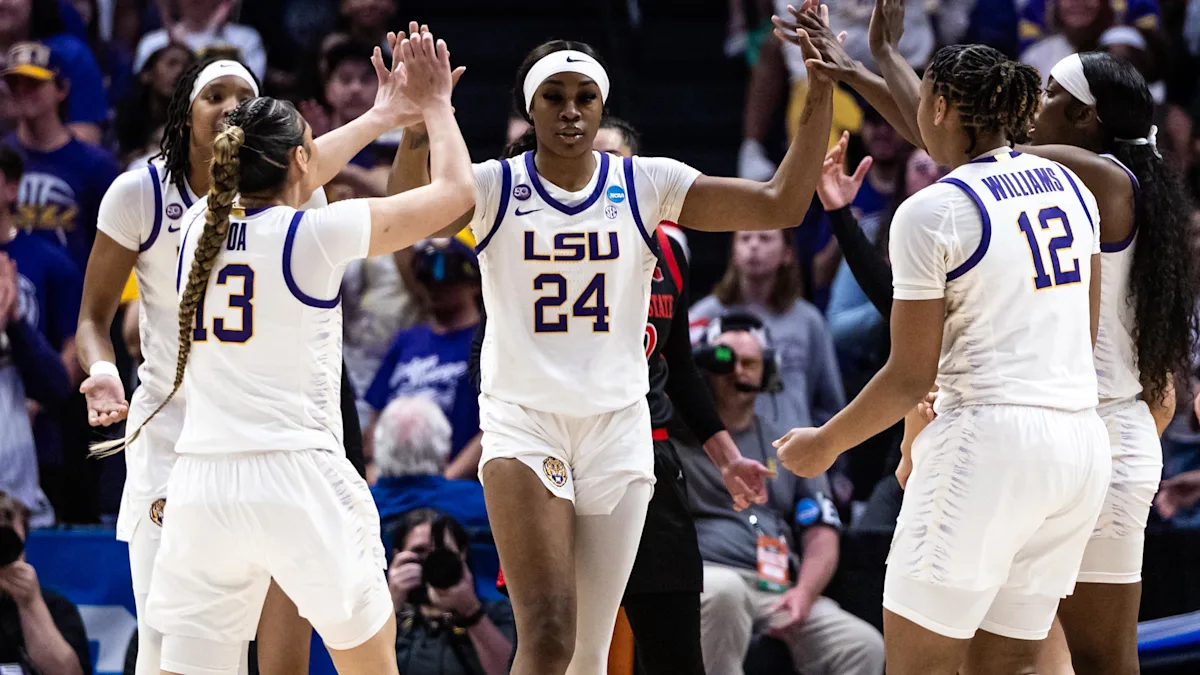What Changed for LSU Women’s Basketball in the Third Quarter vs. Florida State in March Madness
When LSU women’s basketball faced Florida State in the 2025 NCAA Women’s Basketball Tournament, the game appeared to be heading in a familiar direction. The Tigers, led by head coach Kim Mulkey, had built a strong foundation in the first half, but the third quarter saw a dramatic shift that ultimately propelled LSU to victory. The Tigers, who had struggled to maintain control at times, found their rhythm in that crucial period, outscoring the Seminoles and securing a commanding lead that would carry them through to the next round of March Madness.
LSU’s win over Florida State was a testament to their ability to adapt and respond to the pressure of tournament play. While the first half of the game was filled with back-and-forth momentum swings and some early struggles, the third quarter marked a turning point in LSU’s performance. This period of the game was where LSU not only regained control but began to dominate in a way that would ultimately decide the outcome of the contest.
This article delves into the key factors that contributed to LSU’s remarkable turnaround in the third quarter against Florida State. From defensive adjustments and offensive execution to individual player performances and coaching decisions, the transformation in the third quarter was a collective effort that helped LSU move closer to its ultimate goal of a national championship.
The First Half: A Tale of Struggles and Momentum Swings
Before analyzing what changed in the third quarter, it’s important to understand the context of the first half. The opening two quarters of the game were a microcosm of what can often happen in March Madness: the atmosphere was charged, the tension palpable, and neither team was willing to give an inch. Both LSU and Florida State had their moments, and neither team was able to establish dominance for long stretches.
Florida State’s defense was strong early, forcing LSU into tough shots and limiting their offensive opportunities. The Seminoles’ ability to switch defenses, often mixing man-to-man and zone coverage, confused LSU at times. LSU’s offense, which has been a high-powered machine throughout the season, was not firing on all cylinders. The Tigers were shooting below their usual percentage, and players who had been reliable scorers in earlier rounds of the tournament, such as Alexis Morris and Angel Reese, found themselves struggling to find consistent offensive rhythm.
Florida State, on the other hand, capitalized on LSU’s slow start. Their offense, led by standout players like Morgan Jones and Ta’Niya Latson, was sharp. The Seminoles’ athleticism and transition play were challenging for LSU to keep up with, and Florida State managed to keep the score close heading into the halftime break. Florida State’s defense was disrupting LSU’s ball movement, and the Seminoles found success by pushing the pace in transition and limiting second-chance opportunities for LSU.
At halftime, LSU had managed to hold a slim lead, but it was clear that changes needed to be made if they were to pull away in the second half. The game was still within reach for Florida State, and LSU’s offense had yet to find its flow. This set the stage for what would become a pivotal third quarter, a period where the Tigers flipped the script entirely.
The Third Quarter: LSU’s Breakthrough Moment
The start of the third quarter saw LSU come out of the locker room with a newfound energy and intensity. Coach Kim Mulkey’s halftime adjustments had taken hold, and the Tigers’ focus was clear. LSU had struggled to assert their dominance in the first half, but the third quarter was where the team found its rhythm. It was a period of intense defensive pressure, improved shot selection, and faster offensive execution. The Tigers began to control the tempo of the game and took charge on both ends of the floor.
Defensive Adjustments: Increased Pressure on Florida State
One of the most noticeable changes in the third quarter was LSU’s defensive intensity. Throughout the first half, Florida State had been able to find open looks, especially in transition and from the perimeter. In the third quarter, LSU ramped up its defensive pressure, contesting shots more effectively and forcing turnovers.
Coach Mulkey made strategic adjustments to the Tigers’ defensive scheme, specifically focusing on limiting the effectiveness of Florida State’s high-scoring players like Ta’Niya Latson and Morgan Jones. LSU began switching more aggressively on screens and rotating faster, closing out on shooters with more urgency. This defensive disruption stifled Florida State’s offensive flow and forced the Seminoles to take more contested shots. The defensive changes not only disrupted Florida State’s shooting but also created several transition opportunities for LSU.
LSU’s defense became suffocating, particularly in the half-court. The Seminoles were forced into uncomfortable situations where they either missed shots or turned the ball over. In total, LSU forced multiple turnovers in the third quarter, leading to fast-break opportunities. Angel Reese, who had struggled offensively in the first half, began to showcase her prowess on defense, snagging rebounds and making key defensive stops. This pressure turned the momentum in LSU’s favor and allowed the Tigers to take control of the game.
Offensive Execution: A Return to LSU’s Strengths
On the offensive end, LSU started to look more like the team that had been dominating all season. The Tigers found success by executing their plays more effectively, with better ball movement and spacing. Early in the third quarter, LSU was able to generate good looks for both their stars and their role players. A key to their success was better shot selection, as they began to focus on high-percentage shots near the basket, as opposed to forcing perimeter shots when those opportunities weren’t available.
Angel Reese, who had been relatively quiet in the first half, emerged as a dominant force in the third quarter. Her presence in the paint, both as a scorer and a rebounder, was a critical part of LSU’s offensive surge. Reese’s ability to clean up misses and finish strong at the rim gave LSU the confidence it needed to build a lead. Her physicality in the post was something Florida State could not match, and Reese took full advantage of this mismatch.
In addition to Reese, LSU’s perimeter players, including Alexis Morris, began to find their rhythm. Morris, who had been struggling to make shots in the first half, started to hit crucial mid-range jumpers and outside shots. Her offensive spark helped LSU stretch the lead and put more pressure on Florida State, who had been hanging around up until that point. Morris’ ability to score both off the dribble and catch-and-shoot was pivotal in giving LSU the cushion it needed.
Another key offensive adjustment was LSU’s pace. The Tigers, who had been playing at a slower tempo in the first half, began to push the ball more in the third quarter. This shift allowed LSU to get easy transition baskets, taking advantage of Florida State’s defense before it could set. The uptick in pace caught the Seminoles off guard, and LSU capitalized on the quick opportunities to increase their lead.
Angel Reese’s Dominance: A Game-Changer
A major factor in LSU’s success in the third quarter was the dominance of Angel Reese. The junior forward’s impact on both ends of the floor was undeniable, and her ability to assert herself in the paint made her a game-changer. After a relatively quiet first half, Reese took control in the third quarter, not only scoring but also grabbing crucial rebounds and altering Florida State’s offensive flow.
Reese’s physicality and presence in the paint became the defining factor of LSU’s offensive execution. She scored multiple times on second-chance opportunities, using her ability to rebound and put back shots to build LSU’s lead. Her energy was contagious, and it helped ignite LSU’s entire offense. Reese finished the game with a double-double, a performance that underscored her importance to the Tigers’ success in March Madness.
Coaching Adjustments: Kim Mulkey’s Influence
As always, head coach Kim Mulkey played a significant role in LSU’s third-quarter turnaround. Mulkey’s ability to make adjustments and keep her team focused in the heat of March Madness has been a hallmark of her coaching career, and it was evident in this game. She made several key decisions during the halftime break that allowed LSU to reassert control in the third quarter.
Mulkey’s halftime message was clear: the team needed to pick up the intensity on defense, execute better on offense, and play with a sense of urgency. Her emphasis on playing LSU basketball—fast, physical, and relentless—was evident as the Tigers came out of the locker room ready to take charge. Mulkey’s leadership, coupled with the individual performances of her players, was a key factor in the team’s ability to flip the game in their favor.
The Result: LSU Takes Command
By the end of the third quarter, LSU had not only regained control but had also established a significant lead. Florida State, once within striking distance, was now trailing by double digits. The Seminoles were unable to recover from the defensive pressure LSU had applied, and the Tigers’ offensive execution continued to be sharp. LSU’s dominance in the third quarter was a clear turning point in the game, and the Tigers never looked back. They went on to secure a comfortable victory, ultimately advancing to the next round of the NCAA Tournament.
A Pivotal Quarter for LSU’s March Madness Run
LSU’s third-quarter transformation against Florida State was a masterclass in adjustments, resilience, and execution. The team’s ability to respond to adversity and take control of the game was a defining moment of their tournament run. Through stifling defense, efficient offense, and the leadership of players like Angel Reese and Alexis Morris, LSU showcased why they are one of the top teams in the country. As they continue their pursuit of a national championship, this game will serve as a reminder of LSU’s ability to dominate when it matters most.



